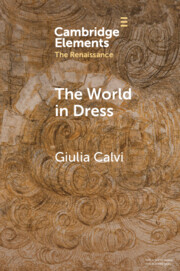Element contents
The World in Dress
Published online by Cambridge University Press: 29 August 2022
Summary
- Type
- Element
- Information
- Series: Elements in the RenaissanceOnline ISBN: 9781108913829Publisher: Cambridge University PressPrint publication: 15 September 2022
Bibliography
Primary Sources
Secondary Sources
- 10
- Cited by

